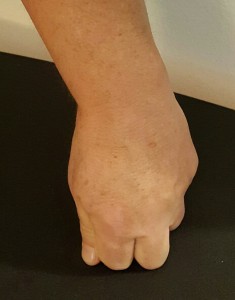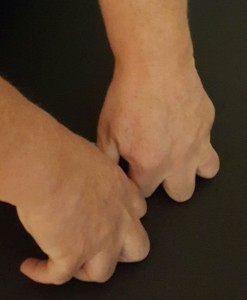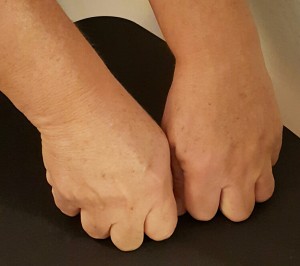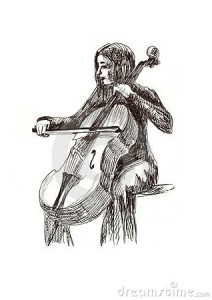I am just back from our massage therapist state convention Classes, networking, stuff to buy and a bit of fun. I had the joy of being a test body, demonstrating treatment by one of the best bodyworkers in the world today.
But the big annual meeting/convention paradigm is changing Conventions are losing attendance, and may be going the way of the pay phone. We have lots of other opportunities to communicate, so fewer therapists every year, also means fewer people selling products, fewer recruiters and fewer classes.
At some point our state meeting may change to every other year, or it may morph into some sort of social event that happens to have some classes the same weekend. They just don’t want to call it a convention, because conventions are losing money.
Well, should the community of massage therapists care? What does a convention do for we who rub?
As someone who has spent 25 to 30 hours a week for the past 20 years in a dimly-lit room, I have to say I like seeing other people who do what I do. It’s a good time to compare notes. How’s business? What are your shoulders feeling like? Find a good program for your schedule? How do you unstick scalenes?
Hey, we can do all this online, of course, but I do like to see folks in person. I notice that the web has replaced much communication, yet people still gather in groups. Perhaps we should have bonfires on the beach, so we can feel our tribalism as in days gone by. Whoop-whoop!
Category Archives: Self-Care
All Thumbs Massage
Massage therapists have a few tricks for using specific pressure techniques without straining their thumbs. Whether light, firm or deep, these handy tips provide support for precious thumb during massage strokes.
These body mechanics require split legs, from 4 inches to shoulder width apart, one behind the other and slightly flexed at the knees and hips. Movement forward springs from the back leg. The visual cue is to imagine your foot pushing the floor away. As you push forward, the hands effleurage the client’s back. When this “fencing lunge” stops, the forward stroke stops. Return strokes should be glides rather than more forceful strokes to avoid activating the lats and rotators, which can lead to shoulder and neck pain.
With these mechanics the length of these strokes depends on the length of the therapist’s arms. Shorter-arm therapists tend to have smaller zones, for instance half the back rather than full length. Taller therapists can cover more territory but are at risk for using their neck and thoracic muscles if they do not take care to split and flex legs.
Here are some photos of thumb-saving stances that allow therapists to work as deeply or lightly as they like. The first is the main thumb saver: Pressing the straight thumb into the flexed index finger and using the other fingers for support. The fingers are flexed so the wrist must be slightly flexed or straight to avoid carpal injury. This allows for stripping along muscle fibers or for transverse friction without risk to the thumb. It also feels better to the client.
The second photo demonstrates the thumbs pressed against each other, but this time the fingers are spread so the massage therapist can knead with the second phalanges of the fingers. This kneading feels more broad and intense top the client than flat finger kneads. Think of it as a step between finger and forearm kneading.
The third photo shows some more thumb stabilization to avoid hyper extension and strain. This time both hands support both thumbs providing a wide and very stable effleurage. 
These thumb tips have kept myself and colleagues out of danger while pursuing long careers in healing. One of my clients calls these strokes the teddy bear paws. Thumbs up!
Taking Chances with Your Massage Muse
Massage therapists are like musicians, athletes and dancers. We train, we practice, and yes, we ache.
Those of us who are in it for real are often playing despite pain. Therapists should be doing all kinds of things to stay in the game, from stretching icing and exercising. But like our musician and dancer friends we are often too busy doing lots of massages and working on our careers to do these things regularly.
Lately folks have wondered about the longevity of a massage therapist’s career based on body mechanics. The stats are kind of miserable: Some newbies are out in three months. The average career is five years. The longer-lasting folks seem invincible but are not really.
My long-timer buddies look fine but have complaints of tendonitis and numb appendages. In my observation, people who work out or do a cardio activity such as cycling seem to wear well. I will think that and then I see a friend out for six months after an accident on the bike.
I suspect there is no magic formula to surviving and thriving in a massage career, but I also suspect that some people leave their starting gates with their feet tied. Hyper-mobile thumbs, hips, shoulders don’t do that well in time. Too stiff people seem to get by but have a lot of osteoarthritis. A long-time therapist friend (25 years) says it all comes down to whether she can play racquetball twice a week.
Well, we all have our goals/expectations.
The older and wiser therapist, has, hopefully learned. My exercise ball is in my living room; another is at the office. My racquetball-crazed friend has her Pilates reformer in her living room. Another has her own cold laser on the nightstand by the bed. How many ice packs can fit in a side-by-side fridge?
We all know the best prevention of all is massage, of course, and when therapists get a massage once a week they seem to do well. How many of us do it? How many of us pay for it?
My master plan is to continue to enjoy doing massages for a good while longer. That takes dedication to prevention. I feel like the musician who has made it to the symphony. I’d better take care of what I have so I don’t have to retire before I am ready.
What is your strategy? Do you have one? Are you dedicated to prevention, the thing we tell all our clients about endlessly?
Plumb Out of Thumb
Body mechanics are important to massage therapists because they can make or break our careers We only have two forearms, two hands and ten fingers So why do many of us take such enormous risks with our thumbs?
When you go to classes for massage, you will hear some jaded tales. “I did this one thing and it took a year to heal.” “I knew it was trouble as soon as I did it.” Or the haughty brag: “I abuse my thumbs all the time and they are fine.” Well, just wait.
Thumb injuries are perhaps worse than the tennis elbow or carpal symptoms many massage therapists can develop because they are a long time healing, prone to immediate re-injury, and crippling for other life activities.
Most of us know better, but sometimes we do something without thinking. (Really?) The thumb can become a lightning rod when injured, because many of our techniques require the use of both pressure and specificity. The thumb provides both, but used recklessly can end your career.
I’m going to list the ‘rules of thumb’ for massage therapists.
Never hike out alone: When the thumb is split away from the fingers, you may think it gives a better sensation of pressure. Actually it does not. The client will feel a marked difference between thumb and finger pressure, not in a good way, while you are risking hyper-extension. At worst, your client will feel as if the thumb is digging while the fingers glide. Your hand, meanwhile, will be all set to resolve that hyper-extension by crimping into flexion while you sleep, compressing the radial nerve and carpal tunnel.
Stick Together: With nearly all massage moves, the thumb should be pressed against and supported by the fingers. This spreads the pressure evenly and results in a glide or effleurage that feels better to the client and to your hand. The entire palm, not just fingers, is used for these moves. What about wringing? Try it with the thumb stuck to the fingers. It will feel better to you and the client.
Thanar, not thumb: When the angle of a stroke tempts you to swing out the thumb, try using the thenar surface, the underside of the thumb, with the upper thumb pressed to the index finger. An example is in trying to shift the lateral quadriceps away from the ilio-tibial band. Using the thenar surface preserves the strength of the stroke without endangering the digit.
Two thumbs and eight fingers are better than one thumb: Depending on the shape and length of your phalanges, you can press two thumbs together to do a specific power glide – as long as the fingers are flexed at the second joint so you are using the thumbs with support on both sides. The second joint is the one just up from the knuckle.
No Lollygagging: Never drag the thumb behind a stroke. This is total thumb suicide.
Lucky for us all, good mechanics also feel much better to the client. If it hurts the client or will hurt you, why do it?
Adding Magnesium to Massage
Got Magnesium?
Turns out that might be a great slogan for massage therapists – if they look both ways and proceed with caution.
Magnesium as a topical aid, and along with ingested and intravenous magnesium, has been used for a very long time in the treatment of muscular cramps and spasms.
Magnesium is the other side of the calcium formula. The movement of calcium ions out of a cell make muscles contract, while magnesium ions make muscle fibers relax. For people in the relax biz, magnesium could come in very handy.
And many folks seeking a massage are likely deficient in magnesium, possibly because we don’t eat enough of the sources – green leafy veggies, beans and bananas.
Should you add magnesium to a massage?
Well, let’s look at what’s out there.
Epsom salt soaks are our most traditional way of introducing topical magnesium. Many therapists make their own retail packages for client to buy or take home after a massage. A few drops of lavender or eucalyptus added to the salts and an organza bag, and the massage therapist has a take-home item for you.
But how many times do you see clients who cannot physically get in or out of a bathtub? Or don’t have a bathtub?
Epsom salt compresses are the next step down – but we all know compliance with this advice may well be zero. What client wants to wrangle wet and dry towels and plastic sheets?
Epsom salt lotions now readily available in most drugstores are another good solution. These do, however, use some pretty synthetic petrochemicals to get the hardy Epsom salts to stay in solution. Some clients don’t want that.
Oh dear, leave it to the healthy marketplace to find solutions.
Now when I head off to the vitamin health food store there’s a little group of magnesium topicals at the ready. And here’s the rub. Some don’t feel real good when applied to the skin.
My favorite one is magnesium oil spray, which is magnesium chloride. Yup, a salt. After a nice vigorous deep tissue massage on my professional test body, my spouse, I added a spritz to a tight shoulder. Immediately producing a stinging feeling described to me as rubbing salt on a wound. Run for the wet towels.
I like to use the magnesium oil spray on myself right after the shower. I tell clients to avoid it after shaving, to avoid the ouch factor.
After that experience with my professional test body I have never sprayed magnesium oil on an area post massage. I notice the makers were suggesting it as a massage oil additive, but after my experience with my unhappy test body, I’m not putting it on freshly massaged skin anytime soon.
Other forms of magnesium abound. I don’t go there with magnesium pills or drinks, largely because that’s not what I do. I massage, and telling someone to take something internally seems a bit out of my expertise area.
But for people who might need it for night cramps or diet deficiency I let them know it is out there, and they need to read and follow directions. Magnesium isn’t good for weak kidneys and in large amounts ingested magnesium is a super-dooper laxative!
Flames Climb Higher Than Hands
Those who do therapeutic massage are well aware of the statistics in the field. Burnout is a huge problem amongst therapists.
What I have often heard from people is that massage is too hard to do enough of it to be secure financially and take care of one’s personal needs as well. I’ve also heard from folks who don’t have much commitment to the field that they are surprised when it turns out massage is work, and they stay in the hobby-job cloud.
I have also heard the burnout complaint from therapists, who don’t charge enough, spend too much on frills or never take a vacation. I’ve never heard it from my core group of friends who have been practicing for nearly 20 years.
So I’m a bit surprised to say that this week I felt burnt out. Yes, dark and twisted like a used paper match. Done inside and out. Phhhht! 
There, I said it. I feel fried!
But I do take vacations – and the occasional mental health day – and I also vary the types of massages I do, and now I even limit the number of massages I do a week. I also coach other therapists and test them on techniques… what on earth is going on?
I think this tiredness is more than just needing a vacation. Next Steps: the self-audit, then the friend audit.
Here’s my list: Eating right? Exercising? Sleeping well? Time for me? Time for non-massage activities? Getting massage once a week? Going for acupuncture or chiro? Am I crabby?
OK, I flunked a bunch of those questions. I had a flood in my house early this year and my days off have been spent dealing with contractors, tossing, organizing and cleaning…my whole holistic schedule went phhhht. I realized the last time I did tai chi was at New Year’s break. So I have been rolling along thinking I was handling all this stuff, and it has caught up with me. One cannot be a balanced therapist without a balanced life.
My friend’s audit was a bit worse. I have been positively snappy when dealing with all the extra chores. Apparently I get up in the morning before work and like one possessed I crank right into my to-do list. Before work.
Well, the list is going bye-bye for now. I’ve booked a massage, a session with my counselor and my tai chi sensei. I’ve been acting like I lived on the kind of schedule my clients come in to undo. Lesson learned!
| Leave a Comment |
Helping your clients set goals for their massage sessions
I always like to check in with new clients on their goals for massage. Do they want to improve sleep, performance, reduce aches, release stress, etc.
I like to give people a few choices on my intake, plus the opportunity to mark “all of the above.” Lots of “aota’s” later, I have come to see what it truly means to some clients. One such new client put it so well:
“I would like to do what I want to do, when I want to do it.”
His statement made us both laugh, because it often sums up what we all want in life: freedom. We want freedom to enjoy activities without thinking about consequences.
I have to admit that massage cannot deliver that goal.
“When I get to that place myself, I’ll let you know,” I said.
Meanwhile, it made me think about what am I really selling as a massage therapist. When I find, treat and track dysfunction I am perhaps vending exactly the opposite: Allowing people the opportunity to choose after careful consideration of their abilities and consequences.
We all have choices, and we make them sometimes a bit too quickly. Choosing to stay at a job that is no longer fair or fun is a choice: people make those decisions for other kinds of rewards. When they come in for massages, I try to help them survive and feel better about that choice.
Massage can’t fix a lot but it can set the mood for people to adapt and make better choices when it comes to stretching, exercise, foods or sleep.
If I think back to my sandbox days, it was all about trying to have things my way – and I was guided to make a better choice for myself and for the future. Human nature, in deed.
Perhaps I would suggest this goal instead:
I would like to be able to do what is good for me, I would like to enjoy doing good for me, and I would like to do it when it is best for me to do it.
Massaging with Partners
Most successful massage therapists come to a time in their careers when they think about going out on their own. They have worked in spas, medical offices or chain clinics and they have an itch to move out and become independent.
Then the question comes up. Why risk all in business? Why not seek out another therapist to partner with?
It’s a natural question and the list of advantages sounds enticing. Half the workload, shared space, some extra hands to help.
I posed the question to my business advisers – a successful small businesswoman, an accountant, a private practice acupuncturist and an attorney: Would a partnership be a good idea?
Here’s what they said:
Businesswoman: It sounds good at first, but partners often don’t do half of the work. They don’t want to clean, or they don’t want to do books or pay for bookkeeping, or they want to take lots of time away from the business. Then when it comes to splitting profits, if there are any, they want half for less work. You will spend more time fighting about issues than just making decisions and implementing them.
Accountant: Partners are great if they have the same work ethic you have. I have never met someone with the same work ethic as me. I have seen people who blow things off if it is inconvenient, or worse, blow off the customers. I work alone.
Acupuncturist: I took on a partner in a real estate investment because I could not afford it on my own. The partner has been extremely difficult to work with. He was supposed to be a silent partner, with me managing the investment. He’ll decide he needs to check on things and comes in and meddles. As soon as he causes problems with the employees, he disappears and leaves me to fix the problems he creates.
I have tried two times to buy him out. Even though it is a good deal for him, as he would get his investment back plus some appreciation, he has backed out at the last minute because he thinks he might be missing out on some money. I just want him out for my peace of mind.
Attorney: If more than half the people with all the best intentions in the world – who know each other intimately – cannot make marriages work, why would you think partnering with someone else would work?
I have to admit I wasn’t prepared for a trip to the dark side of partnerships when I asked my experts. First, I was very glad I asked the question. Second, I took the partnership idea and sent it sailing into the circular file of doom.
Partners? It’s a great idea. Has any massage therapist out there managed to make it work?
The Price of Comfort
Recently I walked into a raging discussion among massage therapists over discount pricing. To discount or not to discount is a huge bugaboo for massage therapists.
Prices are subjective, of course, and one can only wonder why people ask for a discount from a single massage therapist when they wouldn’t dream of asking at a big spa. I came up with a list of concerns about prices:
Overhead: Discounting is tough for all therapists, really, because our  stated prices and what we get paid are quite different. My asking price includes things that support my practice, such as office rent, website, phones, supplies, education and licensing. A friend who does house calls only has the expenses of phone, linens and oil. Another therapist has few expenses as an independent contractor, other than insurance and licensing, but taxes take a much bigger bite out of her paycheck and she rarely makes tips at her chiropractor’s office. At the end of the year, we all make radically different bottom lines, and our prices are quite different.
stated prices and what we get paid are quite different. My asking price includes things that support my practice, such as office rent, website, phones, supplies, education and licensing. A friend who does house calls only has the expenses of phone, linens and oil. Another therapist has few expenses as an independent contractor, other than insurance and licensing, but taxes take a much bigger bite out of her paycheck and she rarely makes tips at her chiropractor’s office. At the end of the year, we all make radically different bottom lines, and our prices are quite different.
Perception: Most of the huffy comments from my friends on this topic come from the feeling that clients who ask for discounts are insulting them or their skills. People don’t haggle over many items, but they do haggle over personal services. My feeling is: do you want to be paid like the maid or the accountant?
Need: We all have clients who come in with limited means and in need of massage. How do you handle these? I have given people discounts for multiple sessions when they clearly have a need and lack resources. However, there are always a few people who ask for discounts and don’t have a need. In my experience, they are either thrifty or culturally used to haggling. I don’t take offense. If they really want a discount for the sake of a discount, I refer them to one of the $39 chains.
Desire: Another therapist friend had a home-based practice, (sub-rosa, no licensing or insurance) and needed clients, so she offered massages for $25 an hour, cash only. It worked. She did not have to leave her house She is also now very burned out and has no savings.
My friend who is a hair stylist put it this way: when she started her practice, her prices were low. As she built clientele, her prices rose. The clients who stayed valued her services. The others, well, one or two come in every year so she can fix their $8 haircut.
| Leave a Comment |
Stress Experts Love Massage
At this time in my massage therapy career, I think I have got the whole stress thing down.
Then something pops up that tells me: HA! Yes, HA! A very karmic and cosmic and pulse-wave HA!
My family and i have been living in a hotel for nearly a month following flooding at my home. A simple toilet clog and my house was drenched with watery pooh. Men in white mooon suits put big hair dryers in every room, and me, the dog and my 90-year-old mother-in-law were off to the land of free hot breakfasts. Oh, did I mention that hunnybuns went to the emergency room? In all the rush for towels, my dear one fell and snapped a thumb ligament.
All together, we are very lucky. Lucky insurance is covering almost everything, lucky the damage was mostly to floors and drywall, lucky hunnybun’s injury was not worse. We are sleeping in nice beds. I don’t have to wash my massage sheets by banging them on a wet rock. During this I have found the stress meter running into the red zone. Yes, that stress meter, the scale I thought I had zenned my way through emerging on the other side a massage therapist for all seasons. I have managed to get to the office and clear my head before sessions, but with a new respect for abrupt chaotic change.
One of my regular clients is also a stress expert. A tax-time CPA and stock market man. He knows what it is like to let the car inch along a half-mile line for the late-open post office on April 15. Those fun moments in the life of a tax guy have diminished now that one can file electronically, but the neck knots are souvenirs. I had to call him to change his appointment time. (Did you know that all the flooring stores close Nt 5? And cabinet stores are all closed on Mondays? I found out.)
We gotta get you out of the hotel, he said. Thanks for understanding and letting me change your appointment, I said. No problem, he said. Trust me I know how bad stress can get. I used to have a small office at the house. I didn’t use it much but occassionaly especially at tax time. I was working 18-hour days one year because I took on too much. I was at the house and getting ready to go to the office when I could not find my wallet. I looked everywhere. It took hours and I went through everything, the car, the house, the office, and no wallet. Finally I had to cancel all my cards and make an appointment for a new ID. I was so upset.
Next day I go into the home office right after my wife was in there getting something and I see the wallet sitting there right in the middle of the desk. I’m like, you just put the wallet there, right? She says no, and I can’t believe it. I’m like you are playing a joke, right? And she starts to get mad at me and says she didn’t go near the desk. The wallet must have been sitting there in plain sight the whole time I was looking for it and I couldn’t see it.
Well, I got stressed out too, I said. This week I convinced a cabinet guy to open the door of his closed shop so I could pick out a vanity. I took hunnybuns for outpatient surgery and played nurse. Do you know you cannot tie shoes with one hand? Or open jars, shower, or fold laundry, or get the leash on the dog?
The kicker is I went over to the house to get the mail after work one evening. I spent 30 minutes trying to squeeze through stacked furniture to get to the mailbox key hung in the kitchen until I gave up and went back to the hotel. Frustration!
Next day we’re having coffee and hunnybuns looks at my car keys and holds them up. What are these?
When we left from the flood I must have put the mailbox keys on my car key chain and forgot. I am so use to having everything in its place i didn’t even check my car keys. Hiding in plain sight!
Stress really can do bad things to your brain….HA!
